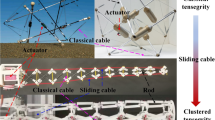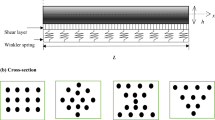Abstract
Common compliant joints generally have limited range of motion, reduced fatigue life and high stress concentration. To overcome these shortcomings, periodically corrugated cantilever beam is applied to design compliant joints. Basic corrugated beam unit is modeled by using pseudo-rigid-body method. The trajectory and deformation behavior of periodically corrugated cantilever beam are estimated by the transformation of coordinate and superposition of the deformation of corrugated beam units. Finite element analysis(FEA) is carried out on corrugated cantilever beam to estimate the accuracy of the pseudo-rigid-body model. Results show that the kinetostatic behaviors obtained by this method, which has a relative error less than 6%, has good applicability and corrugated cantilever beam has the characteristics of a large range of motion and high mechanical strength. The corrugated cantilever beam is then applied to design a flexible rotational joint to obtain a larger angle output. The paper proposes a pseudo-rigid-body model for corrugated cantilever beam and designed a flexible rotational joint with large angle output.
Similar content being viewed by others
References
HOWELL L L. Compliant mechanisms[M]. New York: McGraw-Hill, 2001.
KOTA S, JOO J, LI Z, et al. Design of compliant mechanisms: Applications to MEMS[J]. Analog Integrated Circuits and Signal Processing, 2001, 29(1): 7–15.
PERAI S. Methodology of compliant mechanisms and its current developments in applications: a review[J]. American Journal of Applied Sciences, 2007, 4(3): 160–167.
MCCARTHY J M. 21st century kinematics: synthesis, compliance, and tensegrity[J]. JMR Editorial, 2011, 3(2): 020201.
BENDSOE M P, KIKUCHI N. Generating optimal topologies in structural design using a homogenization method[J]. Computer Methods in Applied Mechanics and Engineering, 1988, 71(2): 197–224.
HAGISHITA T, OHSAKI M. Topology optimization of trusses by growing ground structure method[J]. Structural and Multidisciplinary Optimization, 2009, 37(4): 377–393.
WANG Michael Yu, WANG Xiaoming, GUO Dongming. A level set method for structural topology optimization[J]. Computer Methods in Applied Mechanics and Engineering, 2003, 192(1): 227–246.
WANG Nianfeng, TAI K. Design of grip-and-move manipulators using symmetric path generating compliant mechanisms[J]. Journal of Mechanical Design, Transactions of the ASME, 2008, 130:112305.
WANG Nianfeng, TAI K. Design of 2-DOF compliant mechanisms to form grip-and-move manipulators for 2D workspace[J]. Journal of Mechanical Design, Transactions of the ASME, 2010, 132:031007.
WANG Nianfeng, YANG Yaowen. Structural design optimization subjected to uncertainty using fat Bezier curve[J]. Computer Methods in Applied Mechanics and Engineering, 2009, 199(1): 210–219.
WANG Nianfeng, TAI K. Target matching problems and an adaptive constraint strategy for multiobjective design optimization using genetic algorithms[J]. Computers & Structures, 2010, 88(19):1 064–1 076.
WANG Nianfeng, ZHANG Xianming. Compliant mechanisms design based on pairs of curves[J]. SCIENCE CHINA Technological Sciences, 2012, 55(8): 2 099–2 106.
XIAO Shunli, LI Yangmin, ZHAO Xinhua. Design and analysis of a novel micro-gripper with completely parallel movement of gripping arms[C]//6th IEEE Conference on Industrial Electronics and Applications (ICIEA), Beijing, China, 2011: 2 127–2 132.
WILCOX D L, HOWELL L L. Fully compliant tensural bistable micromechanisms(FTBM)[J]. Journal of Microelectromechanical Systems, 2005, 14(6): 1 223–1 235.
CHEN Guimin, XIONG Botao, HUANG Xinbo. Finding the optimal characteristic parameters for 3R pseudo-rigid-body model using an improved particle swarm optimizer[J]. Precision Engineering, 2011, 35(3): 505–511.
MATTSON C A, HOWELL L L, MAGLEBY S P. Development of commercially viable compliant mechanisms using the pseudorigid-body model: case studies of parallel mechanisms[J]. Journal of Intelligent Material Systems and Structures, 2004, 15(3): 195–202.
SU X P, YANG H S. Two-stage compliant microleverage mechanism optimization in a resonant accelerometer[J]. Structural and Multidisciplinary Optimization, 2001, 22(4): 328–334.
SU H J. A pseudorigid-body 3R model for determining large deflection of cantilever beams subject to tip loads[J]. Journal of Mechanisms and Robotics, 2009, 1: 021008.
TREASE B P, MOON Y M, KOTA S. Design of large-displacement compliant joints[C]//27th Biennial Mechanisms and Robotics Conference, Montreal, Canada, September 29–October 2, 2002: 65–76.
HOWELL L L, MIDHA A. A method for the design of compliant mechanisms with small-length flexural pivots[J]. Journal of Mechanical Design, 1994, 116: 280–290.
Author information
Authors and Affiliations
Corresponding authors
Additional information
This project is supported by National Natural Science Foundation of China (Grant Nos. 51205134, 91223201), Doctoral Fund of Ministry of Education of China (Grant No. 20120172120001), Research Project of State Key Laboratory of Mechanical System and Vibration of China (Grant No. MSV201405), Guangdong Province Universities and Colleges Pearl River Scholar Funded Scheme (GDUPS, 2010), and Fundamental Research Funds for the Central Universities (Grant No. 2013ZM012)
WANG Nianfeng, born in 1977, is currently an associate professor at South China University of Technology, China. He received his PhD degree from Nanyang Technological University, Singapore, in 2008. His research interests include compliant mechanism, structural optimization and robotics.
LIANG Xiaohe, born in 1989, is currently a master candidate at South China University of Technology, China. His research interests include compliant mechanism, precision equipment.
ZHANG Xianmin, born in 1964, is currently a professor at South China University of Technology, China. He received his PhD degree from Beihang University, China, in 1997. His research interests include mechachonics engineering, compliant mechanism.
Rights and permissions
About this article
Cite this article
Wang, N., Liang, X. & Zhang, X. Pseudo-rigid-body model for corrugated cantilever beam used in compliant mechanisms. Chin. J. Mech. Eng. 27, 122–129 (2014). https://doi.org/10.3901/CJME.2014.01.122
Received:
Revised:
Accepted:
Published:
Issue Date:
DOI: https://doi.org/10.3901/CJME.2014.01.122




